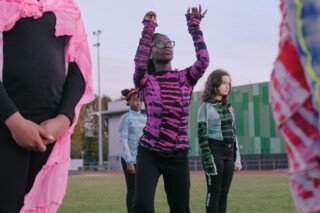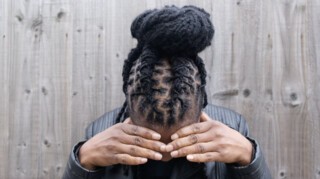On 28 April, a memorial stone for victims of asbestos was unveiled in the town square in Barking, East London. The date was chosen to coincide with International Workers’ Memorial Day, which was inaugurated in 1989 to draw attention to those injured, disabled or killed in the course of their work or because of their working conditions. Many people in Barking still remember Cape, an asbestos factory which operated between 1913 and 1968, whose legacy persists in the extremely high rates of mesothelioma and other asbestos-related cancers in the local area. Ilona Sagar’s film The Body Blow (2022) extends the definition of ‘working conditions’ beyond the factory and into the home. Her interviewees describe housing repairs done on the cheap, leaving asbestos in the walls and ceilings of flats, and women exposed to carcinogenic fibres as they washed their husbands’ overalls.
Sagar’s film, along with new commissioned works by Sonia Boyce, Helen Cammock and Rory Pilgrim, is part of Radio Ballads, a group exhibition which has just come to the end of a run at Serpentine North and Barking Town Hall (in the same square as the new memorial). The Body Blow shares its name with one of the original Radio Ballads, a series of radio documentaries made between 1957 and 1964 by the producer Charles Parker and the musicians Ewan MacColl and Peggy Seeger, and broadcast by the BBC. These documentaries interspersed interviews and field recordings with original songs, composed by Seeger and MacColl, which took their lyrics from the words of the interviewees, including migrant labourers building the M1 and herring fishermen on the coasts of Norfolk and Scotland. The Body Blow, broadcast in 1962 and later released as an album, was a departure from the focus, in the rest of the series, on working lives. Its interviewees were united not by class or occupation but by illness: Parker recorded the voices of people hospitalised with polio, many of them paralysed. At the Serpentine, a CD of Parker, MacColl and Seeger’s The Body Blow has been placed in a vitrine with a chunk of serpentinite – the rock from which chrysotile asbestos is extracted – on loan from UCL’s Department of Earth Sciences. These artefacts are surrounded by books and pamphlets including a history of Cape and The Asbestos Hazards Handbook (1995).
The new Radio Ballads is the result of a three-year engagement between artists, social workers, service users, campaign organisations and other bodies in Barking and Dagenham. It is produced by the Serpentine’s Civic Projects and New Town Culture, an ongoing curatorial programme which, rather than bringing artists into a community to create temporary projects, seeks to recognise the creativity inherent in caring labour. The artists are collaborators rather than ethnographers. A gallery exhibition, with all its spatial and spectatorial conventions, is often where the tensions of socially engaged art like this are most apparent, especially when the intention is to put into practice a concept such as care, as opposed to treating it as a theme, something to make art ‘about’. How do you show the intangible things that happened to make a group cohere, the small cumulative actions and interactions? Who are we looking at in the photographs and videos – are they performers, participants, subjects? Who makes the edit? Where is the art, which bit is the art? These aren’t new questions but they bear repeating.
One response is to have an abundance of documentation. The exhibition booklet asks ‘What are the sounds of care?’, yet the gallery is crowded with images and objects to be looked at, in addition to the dominant screens. Near the research materials compiled by Sagar to accompany her film is a huge spider diagram that shows the connections between artists, curators, organisations and the wider infrastructure supporting Radio Ballads. Framed sketches, letters and paintings by Rory Pilgrim and members of Green Shoes Arts, the Dagenham-based community arts organisation with which he collaborated, spill out from the central room in which Pilgrim’s film Rafts – an ornate, hour-long song cycle incorporating poetry, animation, monologue and dance – is installed; the room itself contains small sculptures and a set of rocks collected by Eddie Paggett, a painter who appears in the film reflecting on ‘care and precision’. Helen Cammock constructs an informal archive and study space around her film Bass Notes and SiteLines: The Voice as a Site of Resistance and the Body as a Site of Resilience. A banner embroidered with the words ‘traverse’, ‘agitate’ and ‘witness’ hangs above a table piled with books by Stuart Hall, Donna Haraway, Audre Lorde and other social and critical theorists, as well as texts on nursing, childcare and social work. (Cammock put together a similar reading table in her Turner Prize-winning installation The Long Note from 2019, a project that examined the history of women’s activism in Derry.)
But who is to say that things other than sounds can’t be listened to? In her voiceover narration, Cammock quotes Tina Campt, whose work argues for a sonic engagement with images. Campt writes about ‘the sonic frequencies of the quotidian practices of Black communities’; these frequencies often go unperceived, but for Campt, and for Cammock, this is their potential – in Campt’s words, they are ‘everyday practices of refusal’. Among her other images, texts and objects, Cammock displays a row of small, squiggly line drawings on coloured paper; in her film we see – and hear – the creation of these works as part of a meditation exercise for social workers. Music plays in the background. These drawings are recordings, too, capturing and inscribing sound.
The women in Cammock’s film all work for or are users of Pause, an organisation for mothers whose children have been (or may yet be) removed from their care. We see them – the social workers, mothers and Cammock herself – taking part in a singing workshop that culminates in a co-written song. The camera seeks out backgrounds and fragments, drawn to hands and feet instead of lingering too long on faces. You could see this as an aesthetic decision, distinguishing artists’ moving image from traditional documentary, although the technique is now familiar from TV too. It is also, of course, a mark of respect for participants who are uneasy about being scrutinised and assessed.
In Cammock’s Bass Notes, both these aspects are in play, but she also reminds us how music is made: in bits, tentative and incremental, and using the whole body. Voices try out sounds, then notes, then phrases. Ideas are notated. One Pause worker says: ‘Music is life.’ Cammock makes claims for music, too: ‘Sounds can be held in our bodies.’ She wonders what music can do to ‘numbness’, by which she means the exhaustion of caring without respite or support. The film suggests at least one answer: music can make time, which may be another way of saying that music is life.
Writing about Radio Ballads in 1981, Ewan MacColl described the recordings of people and locations as ‘actuality’. The term is particular to radio, and perhaps to a certain era of radio, but it’s useful here too. For MacColl and his colleagues, the recorded voices were the raw material for songs; they were also what told the audience that what they were hearing was real. Radio detaches the voice from the body, but as listeners we form an idea of a person, the person has a body that produces a voice, and the voice represents, at least to some extent, who they are. We can then decide who they are in relation to us: a contract that asks to be disrupted in art. This is what Sonia Boyce attempts in Yes, I Hear You, in which interviews with domestic abuse survivors are played over a short four-channel film. A group of performers interprets the transcripts. Unlike, say, Clio Barnard’s film The Arbor (2010), in which actors lip-sync to recordings of interview subjects, these interpretations are not re-voicings but something looser and more open-ended, closer to dance, choreographed and arranged to a great extent by Boyce’s fluid editing. We see hands pulling on a pair of protective gloves – signifying collaborative work in a pandemic – as we hear a woman’s voice on the phone to the police; she needs to get a violent man out of her house. The performers sit in a circle and move around a black box theatre. They dance, clasp hands, stand still and smile to camera. Each is wearing a body-mounted camera, too, supplying exaggerated perspectives of laps, legs and hands. The accounts of abuse, read by actors to detach them from their original speakers, become distributed among the group, which functions as a kind of collective respondent.
The monitors showing Boyce’s film are mounted against wallpaper printed with a drawing of a smashed windscreen. Boyce often makes wallpaper for her installations. Feeling Her Way, this year’s entry for the British Pavilion at the Venice Biennale (where it has just won the Golden Lion award), is papered with a kaleidoscopic pattern of coloured shapes and photographs of lights, microphones and other studio equipment – a background to the screens, which show improvisations and solo sessions by five Black musicians. The wallpaper at the Serpentine makes its point more forcefully. Boyce wants us to see a link between the cracks and splinters and multiple, repeating points of impact on the wall and the way violence recurs and proliferates. In an adjacent room, quotations from some of her interviewees are reproduced in a series of prints, one of which reveals the origin of the windscreen motif. It comes from a social worker who describes the smashed windscreen as an analogy not just for aggression or destruction but for social responsibility: ‘It puts us all in the frame.’
Send Letters To:
The Editor
London Review of Books,
28 Little Russell Street
London, WC1A 2HN
letters@lrb.co.uk
Please include name, address, and a telephone number.



